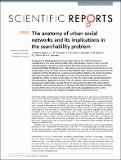| dc.contributor.author | Smoreda, Z. | |
| dc.contributor.author | Zufiria, P. J. | |
| dc.contributor.author | Herrera-Yague, Carlo | |
| dc.contributor.author | Schneider, Christian M. | |
| dc.contributor.author | Benito Zafrilla, Rosa M. | |
| dc.contributor.author | Couronne, T. | |
| dc.contributor.author | Gonzalez, Marta C. | |
| dc.date.accessioned | 2015-09-10T13:05:16Z | |
| dc.date.available | 2015-09-10T13:05:16Z | |
| dc.date.issued | 2015-06 | |
| dc.date.submitted | 2014-10 | |
| dc.identifier.issn | 2045-2322 | |
| dc.identifier.uri | http://hdl.handle.net/1721.1/98430 | |
| dc.description.abstract | The appearance of large geolocated communication datasets has recently increased our understanding of how social networks relate to their physical space. However, many recurrently reported properties, such as the spatial clustering of network communities, have not yet been systematically tested at different scales. In this work we analyze the social network structure of over 25 million phone users from three countries at three different scales: country, provinces and cities. We consistently find that this last urban scenario presents significant differences to common knowledge about social networks. First, the emergence of a giant component in the network seems to be controlled by whether or not the network spans over the entire urban border, almost independently of the population or geographic extension of the city. Second, urban communities are much less geographically clustered than expected. These two findings shed new light on the widely-studied searchability in self-organized networks. By exhaustive simulation of decentralized search strategies we conclude that urban networks are searchable not through geographical proximity as their country-wide counterparts, but through an homophily-driven community structure. | en_US |
| dc.description.sponsorship | New England University Transportation Center (Year 23 Grant) | en_US |
| dc.description.sponsorship | King Abdulaziz City of Science and Technology (Saudia Arabia). Center for Complex Engineering Systems | en_US |
| dc.description.sponsorship | MIT-Accenture Alliance | en_US |
| dc.description.sponsorship | Orange Spain (France Telecom Group) | en_US |
| dc.description.sponsorship | Fundacion Caja Madrid (Spain) | en_US |
| dc.description.sponsorship | Spanish Ministry of Economy and Competitiveness (MINECO) (Grant MTM2012-39101) | en_US |
| dc.language.iso | en_US | |
| dc.publisher | Nature Publishing Group | en_US |
| dc.relation.isversionof | http://dx.doi.org/10.1038/srep10265 | en_US |
| dc.rights | Creative Commons Attribution | en_US |
| dc.rights.uri | http://creativecommons.org/licenses/by/4.0/ | en_US |
| dc.source | Nature Publishing Group | en_US |
| dc.title | The anatomy of urban social networks and its implications in the searchability problem | en_US |
| dc.type | Article | en_US |
| dc.identifier.citation | Herrera-Yague, C., C. M. Schneider, T. Couronne, Z. Smoreda, R. M. Benito, P. J. Zufiria, and M. C. Gonzalez. “The Anatomy of Urban Social Networks and Its Implications in the Searchability Problem.” Scientific Reports 5 (June 2, 2015): 10265. doi:10.1038/srep10265. | en_US |
| dc.contributor.department | Massachusetts Institute of Technology. Department of Civil and Environmental Engineering | en_US |
| dc.contributor.mitauthor | Herrera-Yague, Carlo | en_US |
| dc.contributor.mitauthor | Schneider, Christian M. | en_US |
| dc.contributor.mitauthor | Benito Zafrilla, Rosa M. | en_US |
| dc.contributor.mitauthor | Gonzalez, Marta C. | en_US |
| dc.relation.journal | Scientific Reports | en_US |
| dc.eprint.version | Final published version | en_US |
| dc.type.uri | http://purl.org/eprint/type/JournalArticle | en_US |
| eprint.status | http://purl.org/eprint/status/PeerReviewed | en_US |
| dspace.orderedauthors | Herrera-Yague, C.; Schneider, C. M.; Couronne, T.; Smoreda, Z.; Benito, R. M.; Zufiria, P. J.; Gonzalez, M. C. | en_US |
| dc.identifier.orcid | https://orcid.org/0000-0002-8482-0318 | |
| mit.license | PUBLISHER_CC | en_US |
| mit.metadata.status | Complete | |
